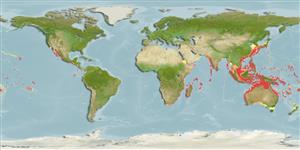Common names from other countries
Environment: milieu / climate zone / depth range / distribution range
Ecología
marino asociado a arrecife; rango de profundidad 10 - 132 m (Ref. 9710). Tropical
Indo-West Pacific: East Africa south to the southeast coast of South Africa (Ref. 5469) and east to Tonga (Ref. 53797), north to southern Japan, south to New Caledonia, southeastern Australia and northern New Zealand.
Tamaño / Peso / Age
Maturity: Lm ? range ? - ? cm
Max length : 15.0 cm TL macho / no sexado; (Ref. 559)
Short description
Claves de identificación | Morfología | Morfometría
Espinas dorsales (total) : 10; Radios blandos dorsales (total) : 16 - 17; Espinas anales: 3; Radios blandos anales: 6 - 7. Body mottled light yellowish to orange-brown; juveniles orange-gold (Ref. 5469).
Found on steep slopes and around small coral heads exposed to currents (Ref. 9710). Hovers several meters above the bottom and feeds mainly on pelagic crustaceans, copepods, and other animals of the plankton. Also found around sponges (Ref 90102).
Life cycle and mating behavior
Maturities | Reproducción | Spawnings | Egg(s) | Fecundities | Larva
Further histological evidence is needed to establish protogyny (Ref. 103751).
Randall, J.E., G.R. Allen and R.C. Steene, 1990. Fishes of the Great Barrier Reef and Coral Sea. University of Hawaii Press, Honolulu, Hawaii. 506 p. (Ref. 2334)
IUCN Red List Status (Ref. 130435)
CITES (Ref. 128078)
Not Evaluated
Threat to humans
Harmless
Human uses
Pesquerías: comercial; Acuario: Comercial
Herramientas
Special reports
Download XML
Fuentes de Internet
Estimates based on models
Preferred temperature (Ref.
115969): 20 - 28.3, mean 26.8 (based on 500 cells).
Phylogenetic diversity index (Ref.
82804): PD
50 = 1.0000 [Uniqueness, from 0.5 = low to 2.0 = high].
Bayesian length-weight: a=0.01585 (0.00637 - 0.03944), b=3.01 (2.79 - 3.23), in cm Total Length, based on LWR estimates for this (Sub)family-body shape (Ref.
93245).
Nivel trófico (Ref.
69278): 3.2 ±0.31 se; based on food items.
Fishing Vulnerability (Ref.
59153): Low vulnerability (10 of 100).
